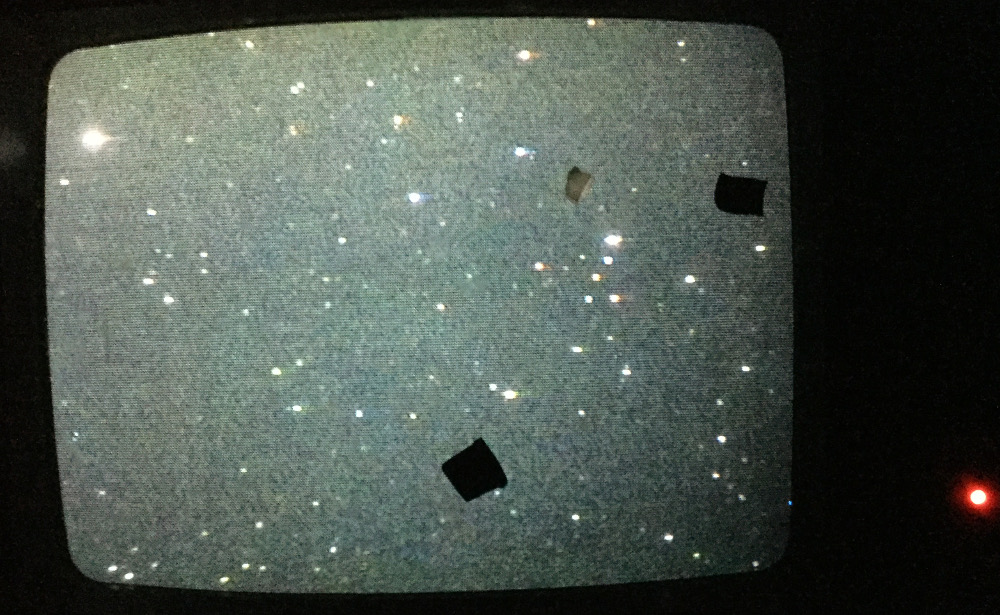
On the night of Nov 12/13, 2020, under good conditions, I acquired images of the eclipsing variable star RT And; one of my capstone students will be analyzing the data later this semester.
I also acquired images of Ross 248 and GX And for our continuing study of their parallax and proper motion.
You can find some basic information on this star at the SIMBAD's page for it.
The main setup was:
Notes from the night:
This yields a focus change of -0.0023 per degree C, quite a bit smaller than the value determined several nights ago.
The object is at
RA = 23 11 17.9 Dec = +52 59 59.2 (J2000)
A chart of the field based on pictures tonight is shown below. The size of the chart is about 38 x 26 arcminutes.

The stars "A", "B", and "C" appear in the charts and tables for this field made by the AAVSO. see
The stars "A", "B", and "C" appear in the charts and tables for this field made by the AAVSO. see
I used the star labelled A = "102" to shift my measurements to the "R" magnitude scale. It has r = 10.127 according to the APASS catalog, but I'm treating "R" and "r" as equivalent for this preliminary work.Here's a picture of the TV with the finder's field of view when pointing at RT And:

The dark current was normal this evening. I forgot to acquire a 10-second dark, so I used a 20-second dark from tonight instead. I checked -- the results look as clean as using a 10-second dark from three nights ago.

The sky value shows that the sky was clear. I STILL don't understand what causes these periodic oscillations in sky value.

The number of objects detected.

I used an aperture of 9 pix = 11.2 arcsec for photometry.

Using aperture photometry with a radius of 9 pixels (binned 2x2, each pixel is 1.25 arcsec, so a radius of 11.2 arcsec), I measured the instrumental magnitudes of a number of reference stars and the target. Following the procedures outlined by Kent Honeycutt's article on inhomogeneous ensemble photometry, I used all stars available in each image to define a reference frame, and measured each star against this frame.
Sigma-vs-mag plots show that the floor was about 0.006 mag with 10-second exposures.

The few jumps in the photometric solution are due to occasional slews to re-center the field.

This is one of the stars that a capstone student may study over the next year in a project involving parallax. Ross 248 is a relatively faint red star surrounded by many other stars of similar brightness, so it's a good candidate for high-precision parallax measurements.
These observations involved:
The object is (currently) near position
RA = 23:41:55.27 Dec = +44:10:06.38 (J2000)
A chart of the field is shown below. The size of the chart is about 41 x 27 arcminutes. The noisy area at right (West) is the shadow of the guider's pickoff mirror.

I've marked the location of several comparison stars.
star UCAC4 B V r ------------------------------------------------------------------------- A UCAC4 671-120730 12.617 10.689 B UCAC4 671-120688 C UCAC4 671-120749 10.987 10.663 P kappa And 4.06 4.14 --------------------------------------------------------------------------
I took a photo of the finder TV's screen when pointing to Ross 248; this could be a useful reference for the future:

The sky value shows no sign of clouds.

The number of objects detected.

The FWHM.

Here are the positions I've measured so far. Note the clear motion to the south-east (lower-left).

Like Ross 248, GX And is a nearby (binary) star which will be the target of a parallax project in the coming year. One of the two components is bright -- about mag V = 8 -- so one must use short exposures to prevent it from saturating the detector. That may mean that this system isn't as easy to measure as Ross 248 or some others.
The object is currently close to this position:
RA = 00:18:28.4 Dec = +44:01:31 (J2000)
but it does have a very high proper motion.
A chart of the field is shown below. The size of the chart is about 41 x 27 arcminutes. The noisy area at right (West) is the shadow of the guider's pickoff mirror.

The two components of the GX And binary sit inside the box. I've marked the location of several comparison stars as well.
star UCAC4 B V r ----------------------------------------------------------- A 671-001473 9.939 9.790 B 670-001639 9.413 8.472 C 671-001509 12.712 11.421 11.001 -----------------------------------------------------------
I took a photo of the finder TV's screen when pointing to GX And; this could be a useful reference for the future:

I took a total of 112 exposures of the field in R-band, using exposure times of 5 seconds.
Using the same techniques as described for earlier nights, I matched detected stellar positions to the Gaia DR2 catalog.
The target is clearly moving in the positive RA and Dec directions, as we would expect from its known (large) proper motion.

Last modified 11/13/2020 by MWR.